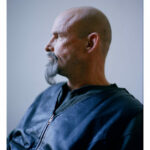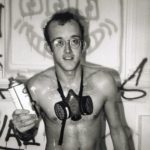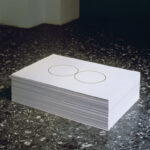Demian DinéYazhi' responds to Art AIDS America
Walking into an art exhibition is like walking into a classroom. Like walking into a waiting room. Like waiting or listening or witnessing. And so I witnessed the space around me and walk into the art exhibition. Art AIDS America, co-curated by Rock Hushka and Jonathan David Katz, describes itself as a “groundbreaking exhibition [that] underscores the deep and unforgettable presence of HIV in American art” and was recently hosted by the Tacoma Art Museum (TAM) in Tacoma, Washington, where I viewed the show. It is now on view at the Bronx Museum of the Arts in New York City. I realize I am walking into this space with a critical lens informed through my personal history of curating and making art about the numerous themes that surround HIV/AIDS-related art and activism. Also, through social media feeds and by responding to a call for entries for a Pacific Northwest response show at the Tacoma Art Museum, Struggle + Strength, curated by Athena Hitson.
Touching Harms the Art
A small reminder to respect the art. A karposi sarcoma tumor erupting from the landscape of a painting. A reminder of the paranoia and miseducation surrounding the HIV/AIDS epidemic and each time this feeling is activated I’m reminded of sitting in a classroom and first hearing of HIV and AIDS. Touching harms the art. A loud reminder that the human body is not to be touched.
Because of the covert, mysterious, and secretive nature of the disease, exposing its intimate history and impact on artists and activists alike takes on an educational tone/subversive didacticism in this type of art exhibition. This is echoed in an Art AIDS America orientation video that plays on loop beside a chronological timeline (1981–2015) that contextualizes the exhibition through curated HIV/AIDS milestones as they apply to art and pop culture, the complexities of American politics and the Western Medical Industrial Complex, HIV infections in the U.S., and the rise and fall of AIDS-related deaths since 1982. I’ll say it again: walking into an art exhibition is like walking into a classroom.
As I enter the space I realize I am entering a space that has been colonized. I realize this art institution is occupying stolen Indigenous S’Puyalupubsh (Puyallup) lands. A colonized people whom are inextricably linked to the threats of extermination through colonization, disease, Western religion, war, and forced relocation faced by countless other Indigenous tribes since unjustified European invasion. A link emerges between the genocide of Indigenous Peoples and the silence, ignorance, and hatred constructed through the paranoid frenzy reinforced by ill-informed citizens, media outlets, and politicians since the onset of the HIV/AIDS crisis. Another link is created through the resilience and acts of Survivance engaged by both oppressed peoples.
The first piece that draws me in is Untitled (Hujar Dead), 1988-89, by David Wojnarowicz. In the piece, amplified spermatozoon made from cut-up maps of the American landscape move around collaged US currency—some cut-up into the shape of red blood cells—while politically-charged, sentimental text lays over black and white images taken just moments after the death of his ex-lover/mentor/friend/accomplice, Peter Hujar. As I imagine the widespread fear of this disease on urban and rural communities in this colonized country, I hear a waterfall of beads swaying in unison like a methodically arranged choir. I notice in an opening on the gallery wall a curtain of iridescent, reflective beads that make up Untitled (Water), 1995, by Felix Gonzalez-Torres.
The installation was a meditative homage to Gonzalez-Torres’s life and love of being surrounded by the ocean and sky during his upbringing in Cuba and when the artist lived in Miami. The work has been recontextualized here to speak of the purification and cleansing qualities of the earthen element. Across the room hangs Unveiling of a Modern Chastity, 1981, by Izhar Patkin, the painting is noted as being “the earliest work in the exhibition, and, in retrospect, one of the earliest AIDS paintings ever.” It evokes the physical, augmented pain and bewilderment imposed on the gay community in those early years. Its surface topographically reaching out to the viewer, breaking the sacred plane of the painting, and conjuring the anxiety and peril experienced by a like-minded character ripped from the pages of an updated HIV/AIDS version of “The Yellow Wallpaper”, by Charlotte Perkins-Gilman.
Patkin’s bold painting was hung in Tacoma alongside a line of related compelling pieces that address the presence of opportunistic skin infections and the humanity eclipsed behind the physical markers; work by Darren Waterson (Isenhein Field, 1995), Judy Chicago (Homosexual Holocaust, Study for Pink Triangle Torture, 1988), and Sue Coe (Karposi’s Sarcoma, 1993). Other pieces in the exhibition expose and resolve themes of erasure, otherness, historical racism, and moral courage, while linking those themes to the HIV/AIDS crisis. In Carrie Yamaoka’s chemically altered print, Steal This Book #2, 1991, Yamaoka washes out pages from Abbie Hoffman’s Steal This Book and focuses on two words taken from the book’s introduction that speak about institutional violence and the genocide of Indigenous Peoples:
slaughter and history.
Indigenous Sicangu Lakota artist Thomas Haukass propels this perspective further in his homage to 19th-century Indigenous Plains ledger art. In the drawing, More Time Expected, 2002, Haukass has placed emphasis on the body of a fallen warrior in a sea of colourful Indigenous warriors to speak of the symbiosis in the fight for Indigenous and HIV/AIDS Survivance. The viewer is left contemplating how this image is to be read from a Native and non-Native lens since the presence of a Queer, gender non-conforming, and HIV/AIDS affected body is obscured on and off Indigenous Reservations due to forced assimilation to Western religious practices, heteropatriarchy, and Western gender, sexuality, and identity mores.
(i Am An Invisible Man), 1993, by Glenn Ligon, is a visually striking piece that utilizes oil and coal dust to speak on the issues of identity, race, blackness, and sexuality. The painting uses repetition and layering to add conceptual weight to the issues at hand until all readability becomes undecipherable as the text moves down to the bottom of the painting like words on a page. The English language is obliterated in an impenetrable landscape of blackness that defies colonial oppression and white systemic hierarchy.
Stepping into the last room in Tacoma the viewer is greeted with a captivating, memorable 16-foot curtain of silk flowers, When We Stay, 1997, by Jim Hodges. Peaking through the gaps of touching flower petals, Luis Cruz Azaceta’s, Babies with AIDS (Bebés con SIDA), 1989, comes into focus and I step around to take a closer look at the immediately recognizable saturated quality of the American flag. However, in this rendition the stars are replaced with 50 human skulls lining the word “AIDS”. Six AIDS-infected fetus umbilical cords are plugged into the symbolic terrain of the blue (“vigilance, perseverance, & justice”) and are scattered atop the skulls and bars to speak of “HIV positive infants [that] were unwanted because their illness and the great cost of their medical care.”
Like much of the demonstrations, activism, and media produced by the grassroots, politically charged, and nonpartisan organization, ACT UP (AIDS Coalition to Unleash Power), Let the Record Show..., was created as a means to spread awareness about the art and politics generated by the group in response to the ongoing HIV/AIDS crisis. In neon lights a pink triangle points toward the sky, and below the triangle appear the words SILENCE=DEATH in white. An LED reader board runs statistical information on the medical and political climate, while a photomural from the Nuremburg trial highlights public figures with their corresponding offensive statements.
I scan the last remaining pieces of the exhibition: a beautifully stitched multimedia print by Hunter Reynolds based on a performance in which the artist wore a dress adorned with names of 25,000 people who died from HIV/AIDS-related complications; a vibrant mixed-media painting by Joey Terrill that explores the daily struggles of living with an HIV/AIDS diagnosis, the contemporary reality of HIV prevention (Truvada/PrEP), and references to the importance of archiving pop and queer culture; and lastly, a bronze altar piece that would be the last work created by Keith Haring while he was hospitalized with AIDS-related illness.
As I leave the exhibition, I realize one unnamed and unintentional piece has remained with me. At times it appeared either bathed in light or it lurked in the shadows, but nonetheless it found its place at various points throughout the exhibition. It sat like a stranger on a bench, waiting with an arm extended, and being refilled continually like a piece by Felix Gonzalez-Torres. It was just an ordinary tissue box, but the context within the Queer, Trans, and HIV/AIDS community is rich and diverse. Hell, it defies stereotype, subversive lifestyles, and/or gender. A Kleenex to wipe off the make-up, to stuff into your pants or under your shirt, or to clean up the saliva, mucus, blood, cum, shit, and, in this case, tears.
However, as angry, devastated, and dispirited as I was, I did not shed a tear walking through the exhibition. On the opening night of the Struggle + Strength (December 17th, 2015) exhibition, artists and activists staged a die-in protest over the lack of diversity of Art AIDS America. If walking through the exhibition is like walking into a classroom, then I was walking into an American history book that was celebrating a White person’s narrative. Carrie Yamaoka’s recontextualisation of Abbie Hoffman’s quote, “Amerika was built on the slaughter of a people”, came to mind again. The surrounding words nearly lost in a whitewashed landscape, but, as time has shown, the defiant energy of a people overpowers any attempt of erasure or ignorance.
It is dangerous to set precedence for an exhibition long before the survivors and inheritors of a great social and political injustice has had the opportunity to experience and respond to the show. The exhibition left me with a sense of pride in the artwork and politically charged nature of existing and perceiving an epidemic and crisis of this scale in one’s lifetime. That much is true. Yet, the exhibition as a whole did not feel complete; it left me wondering what other estimated 1,500 artworks were up for consideration. It’s hard to ignore the fact that the contemporary artwork highlighted in this exhibition is dominated by a white male gaze, which only serves as a reminder of the work that needs to be done—or is continually being done—by non-white or non-male artists and curators in order to create our own spaces for visibility and dialogue.
I wanted to walk away feeling represented by this community, by working artists, and by political activists, instead I walked away feeling that tinge of alienation that tends to creep up at subversive/progressive spaces promising an evolution of Western Queer/Trans culture. I realize this is not only my voice, but it is also the voice of my friends, allies, and accomplices, my Indigenous ancestors, my fellow Queer/Trans artists/activists, and all the past/present/future artists, activists, survivors, and casualties of the HIV/AIDS epidemic, colonization, genocide, and other immoral, horrific things. These sentiments are embedded in the politics of those whom have lost their lives—or whom are in threat of losing their life—to the unnatural and corrupt machine that has made our existence a political force to be reckoned with: Western Civilization.
As troublesome as this feeling can be, this is ultimately where I find the strength to survive. Writing this now, I realize this is where I find the determination to make art, write, and create. And so I walk away, drive past the 18-foot Marie Watt bronze cast sculpture pressed up against the museum, and make advances toward building the world Vito Russo dreamt of and fought until the death to bring to life: “Someday, the AIDS crisis will be over. Remember that. And when that day comes -- when that day has come and gone, there'll be people alive on this earth -- gay people and straight people, men and women, black and white, who will hear the story that once there was a terrible disease in this country and all over the world, and that a brave group of people stood up and fought and, in some cases, gave their lives, so that other people might live and be free.... And then, after we kick the shit out of this disease, we're all going to be alive to kick the shit out of this system, so that this never happens again.”
Demian Dinéyazhi’ (born 1983) is an indigenous Diné (Navajo) transdisciplinary artist. His work is rooted in Radical Indigenous Queer Feminist ideology, landscape representation, memory, HIV/AIDS-related art & activism, gender, identity, & sexuality, Indigenous Survivance, & Decolonization. He received his BFA in Intermedia Arts from Pacific Northwest College of Art in 2014. He is the founded/director of the Indigenous artist/activist initiative, R.I.S.E.: Radical Indigenous Survivance & Empowerment, which is dedicated to the perseverance, education, and evolution of Indigenous art & culture. He lives & works in the Indigenous Lands of the Multnomah Tribe (Portland, Oregon). www.demiandineyazhi.com // @heterogeneoushomosexual


















